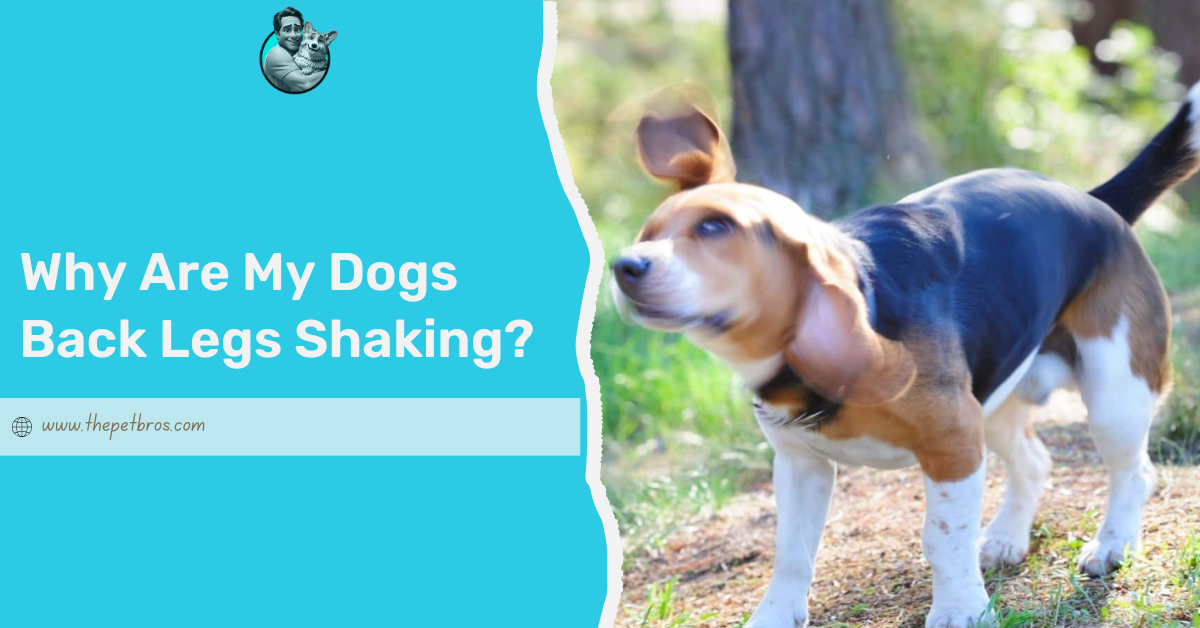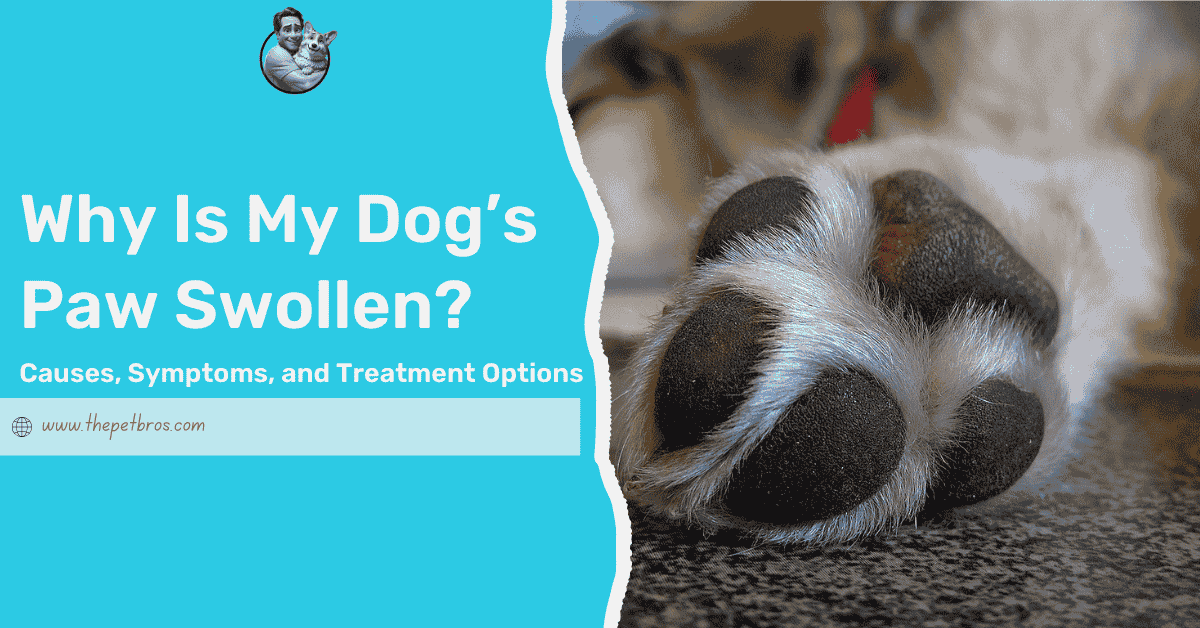There’s nothing quite as heartbreaking as seeing your dog trembling, especially when your dog’s back legs are shaking uncontrollably. One minute, they play around, and the next, their legs seem weak, unsteady, as though experiencing leg tremor.. This alone is enough to worry you because you just need answers. Is it a harmless twitch, or could it be something serious?
Don’t worry, you are about to find out. So, before you fear the worst and start panicking, I have a perfectly reasonable explanation. Continue reading to find out why your dog’s back legs are shaking and what you can do to help them feel better.
Why Are My Dogs’ Back Legs Shaking?
Your dog’s back legs may be shaking for various reasons including muscle fatigue, temperature-induced shivering, pain and joint problems, degenerative myelopathy, shaker syndrome, and intervertebral disc disease.
However, some of these reasons are completely harmless. Regardless of the situation, understanding the root cause is key and the possible treatment options available for you to explore:
1. Muscle Fatigue
Dogs experience muscle fatigue after intense physical activities like running or exercising. This is especially common in high-energy breeds such as Border Collies, Labrador Retrievers, and Jack Russell Terriers, who often push themselves to the limit without realising they need rest.
Although fatigue is generally harmless and resolves with rest, frequent or prolonged shaking could indicate an underlying issue. Older dogs, especially, may experience muscle tremors more often due to reduced muscle strength and slower recovery times. Also, dehydration and lacking essential minerals like potassium and calcium can worsen muscle tremors.
Treatment Options: After exercises, allow your dog to rest and ensure it has access to fresh water. Providing a comfortable, warm place to relax can also help. If the shaking of the back leg persists or worsens, consult a vet to rule out more serious conditions such as muscle disorders or joint problems.
2. Temperature-Induced Shivering
Like humans, dogs shiver when they’re cold. Small breeds, short-haired dogs, and older canines are especially prone to this, as they struggle to retain body heat. If your dog’s back legs shake more in winter or after being outside in chilly weather, blame the cold.
Breeds like Chihuahuas, Greyhounds, and Dachshunds are susceptible to low temperatures and often need extra warmth. Cold-induced shaking isn’t necessarily dangerous, but prolonged exposure to freezing conditions can lead to hypothermia.
Hypothermia occurs when a dog’s body temperature drops dangerously low, causing weakness, confusion, and severe tremors. Puppies, elderly dogs, and those with health conditions are at higher risk.
Treatment Options: Simply provide your dog with a warm blanket or a heated dog bed. Consider investing in a dog sweater or coat for outdoor walks, particularly for breeds that struggle with low temperatures.
3. Pain and Joint Problems
Pain, muscle strains, ligament injuries, or joint problems can all lead to tremors as the body reacts to discomfort. Dogs with arthritis, hip dysplasia, or cruciate ligament injuries may exhibit back leg shaking, particularly after movement or prolonged standing.
Large breeds like German Shepherds, Labrador Retrievers, and Golden Retrievers are especially prone to joint-related issues. An injury could be the culprit if your dog suddenly starts shaking their back legs and shows signs like limping, whimpering, or reluctance to move.
Arthritis is another common culprit, especially in senior dogs, as the inflammation in their joints makes movement painful, leading to shaking and stiffness.
Treatment Options: Managing pain-related shaking depends on the underlying cause. Rest and anti-inflammatory medication (prescribed by a vet) may help with injuries. Dogs with arthritis may benefit from joint supplements, pain relief medication, and physical therapy. In severe cases, surgery might be necessary.
4. Degenerative Myelopathy
Degenerative Myelopathy (DM) is a condition that affects the spinal cord, leading to progressive weakness and loss of coordination in the back legs. It’s most commonly seen in older dogs, particularly German Shepherds, Boxers, and Corgis. In the early stages, dogs may experience mild shaking or wobbliness in their hind legs, which gradually worsens over time.
Unfortunately, DM is a progressive disease, meaning it gets worse as it advances. As the spinal cord deteriorates, dogs lose the ability to control their back legs, eventually leading to paralysis. Unlike arthritis, DM is not a painful condition, but it severely impacts mobility and quality of life.
Treatment Options: Supportive care can help manage symptoms. Physical therapy, hydrotherapy, and mobility aids like dog wheelchairs can improve a dog’s quality of life. Supplements such as vitamin E, B12, and omega-3 fatty acids may help slow the progression.
5. Shaker Syndrome
Shaker Syndrome, or Generalised Tremor Syndrome (GTS), is a neurological condition that causes involuntary shaking in dogs. It is commonly seen in small-breed dogs, particularly Maltese, West Highland White Terriers, and Poodles. While it can affect the entire body, many cases involve tremors concentrated in the back legs.
We don’t fully understand the exact cause of Shaker Syndrome. However, it is associated with an autoimmune response affecting the nervous system. Dogs with this condition typically develop symptoms between six months and three years of age, and the tremors often worsen with excitement or stress.
Treatment Options: The good news is that Shaker Syndrome is treatable. Most dogs respond well to corticosteroids like prednisone, which help reduce inflammation in the nervous system. In many cases, symptoms improve within a few weeks of starting treatment.
6. Intervertebral Disc Disease (IVDD)
Intervertebral Disc Disease (IVDD) is another spinal condition that occurs when the discs between a dog’s vertebrae degenerate or slip. Unfortunately, this puts pressure on the spinal cord and causes pain, weakness, and tremors in the back legs. Breeds like Dachshunds, French Bulldogs, and Beagles are susceptible due to their long spines and genetic predisposition.
Dogs with IVDD may show signs of back leg shaking, difficulty standing, or even sudden paralysis. The severity of symptoms depends on the degree of spinal compression. In mild cases, dogs may experience occasional tremors and stiffness, while severe cases can result in complete loss of mobility.
Treatment Options: Treatment for IVDD depends on the severity of the condition. Mild cases can often be managed with anti-inflammatory medication, crate rest, and physical therapy. Severe cases may require surgery to relieve spinal pressure. Weight management and avoiding high-impact activities (like jumping off furniture) can help reduce the risk of IVDD-related issues.
How Do I Help If My Dog Back Legs Are Shaking?
Although some severe cases require veterinary attention, you can manage others at home with lifestyle changes, supportive care, and preventive measures. So, how can you help your dog regain comfort and stability?
1. Consult a Veterinarian
Causes like degenerative myelopathy or intervertebral disc disease require early intervention for the best outcome. If your dog’s tremors persist, worsen, or are accompanied by symptoms like weakness, limping, or pain, book a veterinary appointment immediately.
Your vet will most likely perform:
- Physical Examination: Here, they check for signs of injury, muscle loss, or joint problems.
- Blood Tests: This helps them identify underlying health issues like electrolyte imbalances or toxin exposure.
- X-rays or MRI Scans: To diagnose structural problems such as arthritis or spinal disorders.
- Neurological Tests: To evaluate nerve function to rule out degenerative conditions.
2. Implement Long-Term Strengthening Exercises
Preventative care is just as important as treatment. Strengthening your dog’s muscles and joints can reduce the likelihood of tremors, especially in ageing dogs or those prone to conditions like arthritis.
Incorporate the following into their routine:
- Regular, Low-Impact Exercise: This includes swimming, slow, controlled walks, and physiotherapy exercises prescribed by a veterinarian.
- Joint and Nerve Health Support: Ensure the use of Omega-3 supplements as they support joint and nerve function. Additionally, always give your dog a high-quality, protein-rich diet:
- Weight Management: Keeping your dog at a healthy weight reduces strain on their joints and spine. Therefore, avoid overfeeding or excessive treats, especially in breeds prone to obesity.
3. Provide Supportive Care at Home
If your vet says that your dog’s back leg shaking isn’t due to a life-threatening condition, you can help manage their symptoms at home in several ways.
- Prioritise Proper Rest: If overexertion is the cause, allow your dog to rest and recover. Limit strenuous activities like running or jumping.
- Offer a Comfortable Sleeping Area: Orthopaedic beds can help dogs with arthritis or joint pain rest more comfortably.
- Monitor Temperature Changes: If cold weather triggers tremors, keep your dog warm with blankets or a dog coat during walks.
- Hydration and Nutrition: Ensure your dog has access to fresh water and a balanced diet to prevent electrolyte imbalances that could contribute to shaking.
- Gentle Massage and Stretching: Massaging your dog’s legs or performing light stretching (under vet guidance) can improve circulation and ease muscle tension.
- Mobility Aids: For dogs struggling with mobility issues, ramps, harnesses, or even dog wheelchairs can provide extra support.
Are Your Dog’s Back Legs Still Shaking?
Early intervention makes all the difference from something as simple as muscle fatigue to more serious conditions like degenerative myelopathy. And the best part? You’re already seeking answers. A caring pet parent like you makes all the difference in your dog’s life.
With the proper care, you can help your dog stay happy, comfortable, and mobile forever. So if their back legs are shaking, don’t ignore it. Instead, take action, give them the support they need, and ensure they get the best care.
Frequently Asked Questions
Why Does My Dog Stand on Three Legs Instead of Four?
If your dog frequently lifts one of its legs and avoids putting weight on it, this could be a sign of pain, injury, or an underlying health issue. However, if the behaviour persists and is accompanied by limping or swollen toes, I recommend a vet visit to diagnose and treat the issue properly.
Can My Dog’s Back Legs Suddenly Become Weak?
Yes. However, do not fret. This issue could be due to trauma, a slipped disc, blood clots (such as a fibrocartilaginous embolism), or tick paralysis. Ensure to seek emergency veterinary care to understand the root cause. Remember, early intervention is key.














